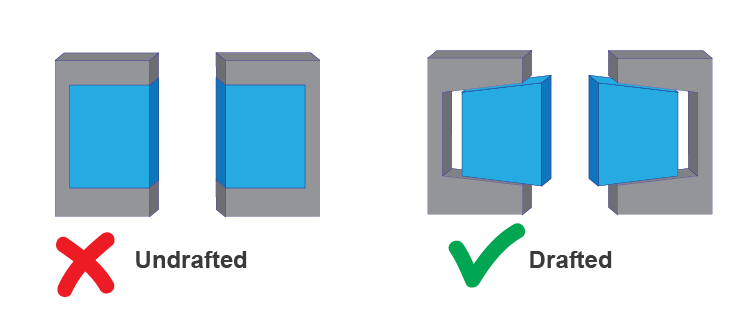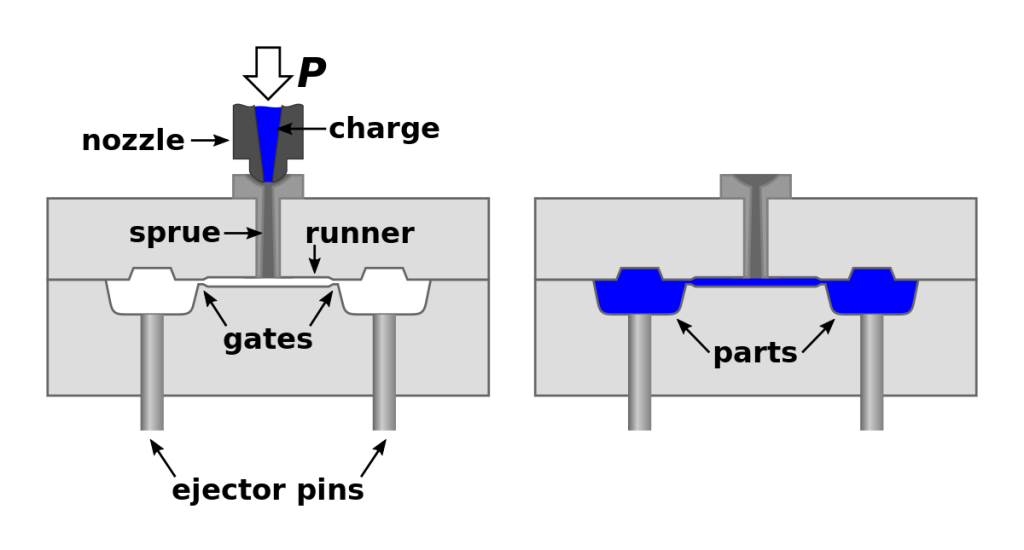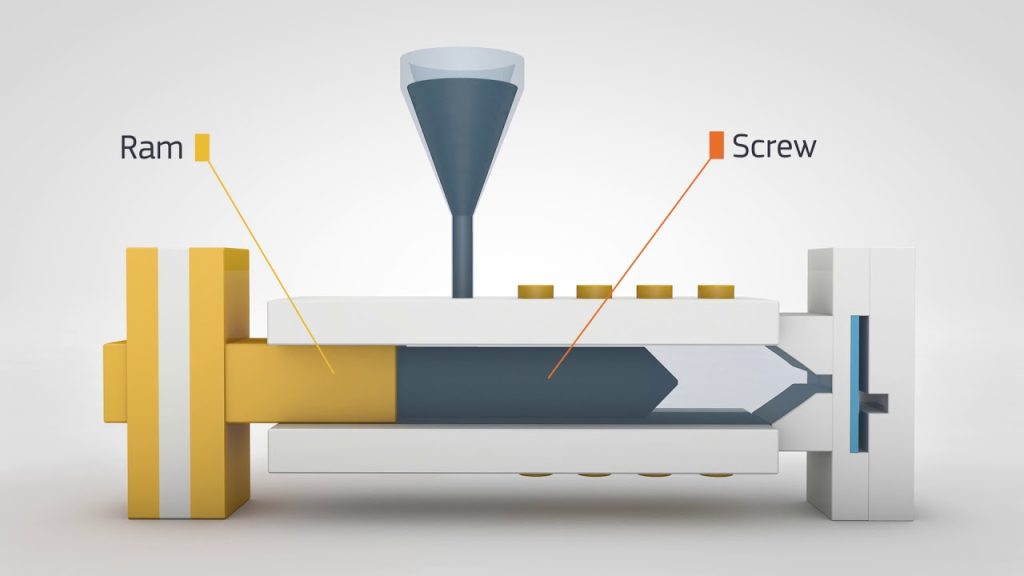Table of Contents
If you have ever wondered how plastic products are made, then you might have come across the term draft angle injection molding. This manufacturing process has been around for decades and has revolutionized the production of plastic products.
In simple terms, draft angle injection molding is a technique that involves injecting molten plastic into a mold cavity to create a product. But there is more to it than just that. In this article, we will delve deeper into what draft angle injection molding is, how it works, and its benefits in the manufacturing industry. So, let’s get started!
Draft angle injection molding is a design technique used in injection molding to facilitate the easy ejection of parts from the mold. It involves tapering the sides of a mold cavity to allow for the smooth removal of the molded part. The angle of taper is called the draft angle, and it must be carefully calculated to ensure the integrity of the final product. Draft angle injection molding is essential for the production of high-quality and precise plastic parts.
What is Draft Angle Injection Molding?
Draft angle injection molding is a technique used in the manufacturing of plastic products. It involves the creation of a tapered feature on the surface of a mold, which allows for easy removal of the finished product. This technique is particularly useful when producing complex shapes and designs that require intricate details and sharp angles.
How Does Draft Angle Injection Molding Work?
Draft angle injection molding involves the use of a mold that has a tapered feature on its surface. The mold is then filled with molten plastic material, which is allowed to cool and solidify. Once the plastic has hardened, the mold is opened, and the finished product is removed from the mold.
The tapered feature on the mold allows for the easy removal of the finished product, as it creates a space between the product and the mold. This means that the product can be removed without damaging the mold or the product itself.
Benefits of Draft Angle Injection Molding
There are several benefits to using draft angle injection molding in the production of plastic products. These benefits include:
- Reduced production time: Draft angle injection molding allows for faster production times, as it eliminates the need for additional finishing processes.
- Increased accuracy: This technique allows for the production of highly accurate and detailed products, with sharp angles and intricate designs.
- Improved product quality: Draft angle injection molding produces high-quality products that are free from defects and imperfections.
- Cost-effective: This technique is cost-effective, as it requires less material and reduces waste.
Draft Angle Injection Molding vs. Traditional Injection Molding
Traditional injection molding involves the use of a mold with a flat surface. This means that the finished product can be difficult to remove from the mold, as it can become stuck. This often requires additional finishing processes, which can increase production time and cost.
Draft angle injection molding, on the other hand, allows for easy removal of the finished product, without the need for additional finishing processes. This makes it a more efficient and cost-effective technique for producing plastic products.
Applications of Draft Angle Injection Molding
Draft angle injection molding is widely used in the production of a variety of plastic products, including:
- Toys and games
- Automotive parts
- Medical devices
- Electronic components
- Household appliances
This technique is particularly useful when producing products with complex shapes and designs, as it allows for the creation of highly accurate and detailed products.
Types of Draft Angles
There are several types of draft angles that can be used in injection molding, including:
- Positive draft angle: This type of draft angle slopes outward from the center of the mold.
- Negative draft angle: This type of draft angle slopes inward toward the center of the mold.
- Zero draft angle: This type of draft angle has no taper and is perpendicular to the mold surface.
The type of draft angle used will depend on the specific requirements of the product being produced.
Conclusion
Draft angle injection molding is a highly efficient and cost-effective technique for producing plastic products. It allows for the creation of highly accurate and detailed products, with complex shapes and designs. By using a tapered feature on the surface of the mold, this technique enables easy removal of the finished product, reducing production time and cost. Whether it’s for manufacturing toys and games or electronic components, draft angle injection molding is a versatile technique that can be used in a wide range of applications.
Frequently Asked Questions
In injection molding, draft angle plays a significant role in the manufacturing process. Draft angles are necessary to ensure that the finished product can be easily ejected from the mold. Here are some frequently asked questions about draft angle injection molding.
What is draft angle injection molding?
Draft angle injection molding is a manufacturing process that involves the creation of a mold, which is used to produce plastic parts. The mold has a draft angle, which is the angle that is added to the vertical walls of the mold. The draft angle is necessary to allow the plastic parts to be easily released from the mold.
The draft angle is critical because it affects the quality of the finished product. If the draft angle is too shallow, the plastic parts may stick to the mold, or they may be deformed when they are released. On the other hand, if the draft angle is too steep, the parts may be difficult to remove from the mold, or they may be damaged during the ejection process.
Why is draft angle important in injection molding?
Draft angle is essential in injection molding because it ensures that the finished product can be easily removed from the mold. Without a draft angle, the plastic parts would be stuck to the mold, or they would be deformed when they are released.
The draft angle also affects the overall quality of the finished product. If the draft angle is too shallow, the plastic parts may have defects, such as sink marks or warping. If the draft angle is too steep, the parts may be difficult to remove from the mold, or they may be damaged during the ejection process.
How is draft angle determined in injection molding?
Draft angle is determined by a number of factors, including the geometry of the part, the type of plastic being used, and the design of the mold. Typically, a draft angle of 1 to 2 degrees is used for most injection molding applications.
However, the draft angle may need to be adjusted depending on the specific requirements of the part. For example, if the part has a complex geometry, a larger draft angle may be required to ensure that the part can be easily removed from the mold.
What are the benefits of using draft angle injection molding?
There are several benefits to using draft angle injection molding. First, it ensures that the finished product can be easily removed from the mold, which reduces the risk of damage to the part. Second, it helps to prevent defects, such as sink marks or warping.
Third, it can help to reduce the cost of manufacturing by minimizing the amount of material that is wasted. Finally, it allows for greater design flexibility, as it enables the creation of more complex geometries that would be difficult or impossible to produce without a draft angle.
What are some common problems with draft angle injection molding?
One common problem with draft angle injection molding is over-drafting. This occurs when the draft angle is too steep, which can cause the part to be damaged during the ejection process.
Another issue is under-drafting, which occurs when the draft angle is too shallow. This can result in the plastic parts sticking to the mold, or they may be deformed when they are released. Additionally, improper draft angles can result in sink marks, warping, or other defects in the finished product.
In conclusion, draft angle injection molding is an essential aspect of the manufacturing process that is commonly used in the production of plastic parts. It is a technique that ensures the easy ejection of the finished product from the mold without causing any damage to the material or the mold itself.
The importance of draft angles in injection molding cannot be overstated. Without a proper draft angle, the final product may become stuck in the mold, leading to costly delays and damage to the mold. A well-designed draft angle can also improve the overall quality of the finished product by reducing the risk of defects and improving surface finish.
In summary, draft angle injection molding is a crucial technique that helps manufacturers achieve high-quality products while minimizing production costs. By understanding the importance of draft angles and implementing them correctly, businesses can ensure the success of their injection molding projects and maintain a competitive edge in the market.
Request a quote today!
[contact-form-7 id="1578" title="Contact form"]
Please compress the file into a ZIP or RAR file before uploading. Alternatively, send through your RFQ by email.
enquires@unitymanufacture.com





